This delectable vegan lemon pistachio cake is both grain free and gluten free, which makes it suitable for lots of eating styles. It’s made with coconut flour, almond flour, and finely ground pistachios. It also has a tart, sweet lemon glaze.
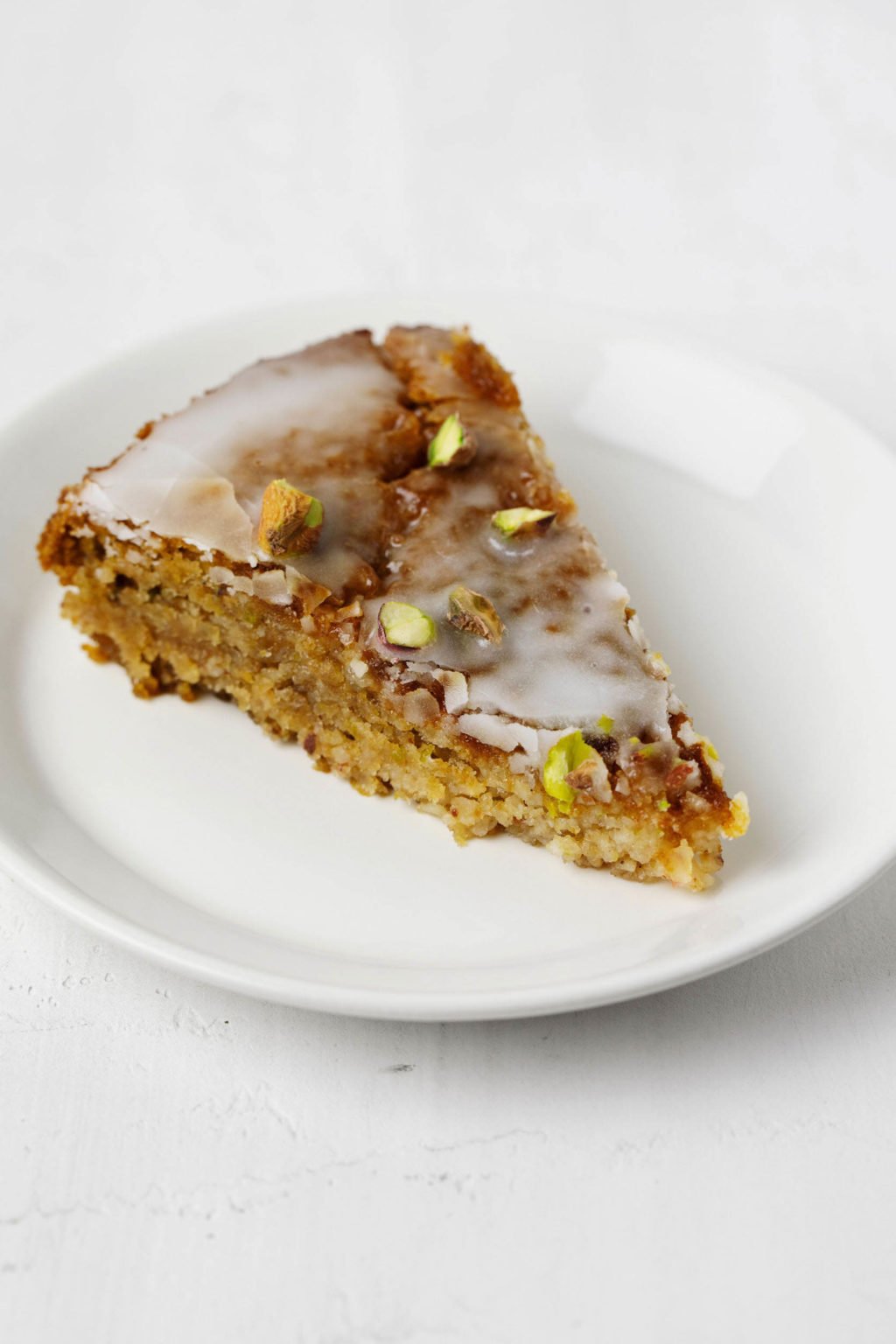
Anyone who has read this blog for some time knows that I am no stranger to vegan cake.
Cake is my favorite type of dessert. If I were given the choice between cake and other sweets—cookies, pudding, ice cream, crème brûlée, pie—I’d choose cake. Every. Single. Time.
Many of my cake recipes begin with a similar combination and ratio of dry ingredients to wet. From there, I’ve varied flavors and textures, from carrot cake to classic vanilla cake to more unusual offerings, like chocolate beet cake or golden milk cake.
This vegan lemon pistachio cake, unlike nearly all of my others, is a big step outside of my comfort zone!
I first created the cake when I attended a Passover seder with some chosen family: my closest friend from college, Jordan, and his parents and siblings.
Jordan’s mom has always welcomed me to contribute a vegan recipe when I join the family for holidays. At Rosh Hashana, this means a crown-shaped loaf of challah.
At Passover, it means the challenge of something plant-based and also grain-free.
This presents quite a challenge. Grains are a cornerstone of my every day diet as well as my baking. When I made this pistachio cake, it was my first attempt ever to create a recipe that was intentionally grain-free.
While grain-free baking won’t ever be my norm, it was interesting to create something that didn’t rely on regular flour for texture. And, though the cake is very different from the cakes that I have created in the past, it has become a favorite of mine for its own reasons.
Why grain-free?
In the case of this pistachio cake, there is a simple explanation: I first made it for a Passover celebration. One of the dietary modifications for Passover is avoidance of grains that can be leavened through fermentation.
I could have chosen to use quinoa flour, as quinoa isn’t a grain, technically speaking.
However, I decided instead to take up the challenge of making a grain-free vegan cake. Grain-free eating may not align with my own preferences, but it’s a style that appeals to others. I’m always happy to create vegan recipes that fit can fit many ways of eating.
Grain free flours for vegan baking
For this cake, I used a combination of almond flour, coconut flour, and pistachio flour. The pistachio flour could be prepared at home by grinding pistachios very finely (think: as powdery as possible) in a food processor.
You can also purchase pistachio flour online. It’s a pricey flour to invest in, but if you do a lot of grain-free baking, then it might be a fun investment. And you can make a bag stretch if you use it in combination with other grain-free flours.
One of the challenges of grain-free baking for vegans is that it’s hard to get rise and fluffy texture in baked goods.
Many recipes that call for almond or coconut flour employ eggs for leavening and tenderness. Without eggs, these flours are more of a challenge. My experiments in using almond flour without a grain flour or starches has resulted in many dense baked goods.
In fairness, this lemon pistachio cake is a bit dense, too. But I think that it works for this particular recipe. In fact, it’s quite delicious: think what it would be like if marzipan became a cake!
I wouldn’t have been able to take this grain-free baking adventure without some guidance from pros. One is Lindsay of the blog Cotter Crunch. I was so impressed with the fluffiness of her grain free vegan white cake recipe.
I also took note of this pistachio cake by Nigel Slater, adapted by Julie Powell. It looked beautiful, but I knew I’d need to tweak it considerably to make it vegan.
I thought back to Lindsay’s cake, and I wondered if I couldn’t create some sort of amalgam of the two. That effort is what guided me as I developed the vegan lemon pistachio cake recipe.
How does the lemon pistachio cake rise?
Speaking of leavening, I used baking powder and baking soda to create rise in the cake. I came up against some confusion about whether these leavening agents are acceptable for Passover.
After doing a little research, I learned that the prohibition on leavened grains applies specifically to leavening through fermentation.
Since chemical leavening agents don’t create leavening through fermentation, baking soda and baking powder can be permissible for Passover.
Apparently, Kosher for Passover baking powder and baking soda can be found in Orthodox neighborhoods, though they may be harder to locate in major grocers.
Can I substitute pistachios or pistachio flour?
Yes, absolutely. The pistachio flour in this recipe can be substituted with additional blanched, superfine almond flour.
In this case, the cake will become an almond coconut cake. Different, yet still delightful.
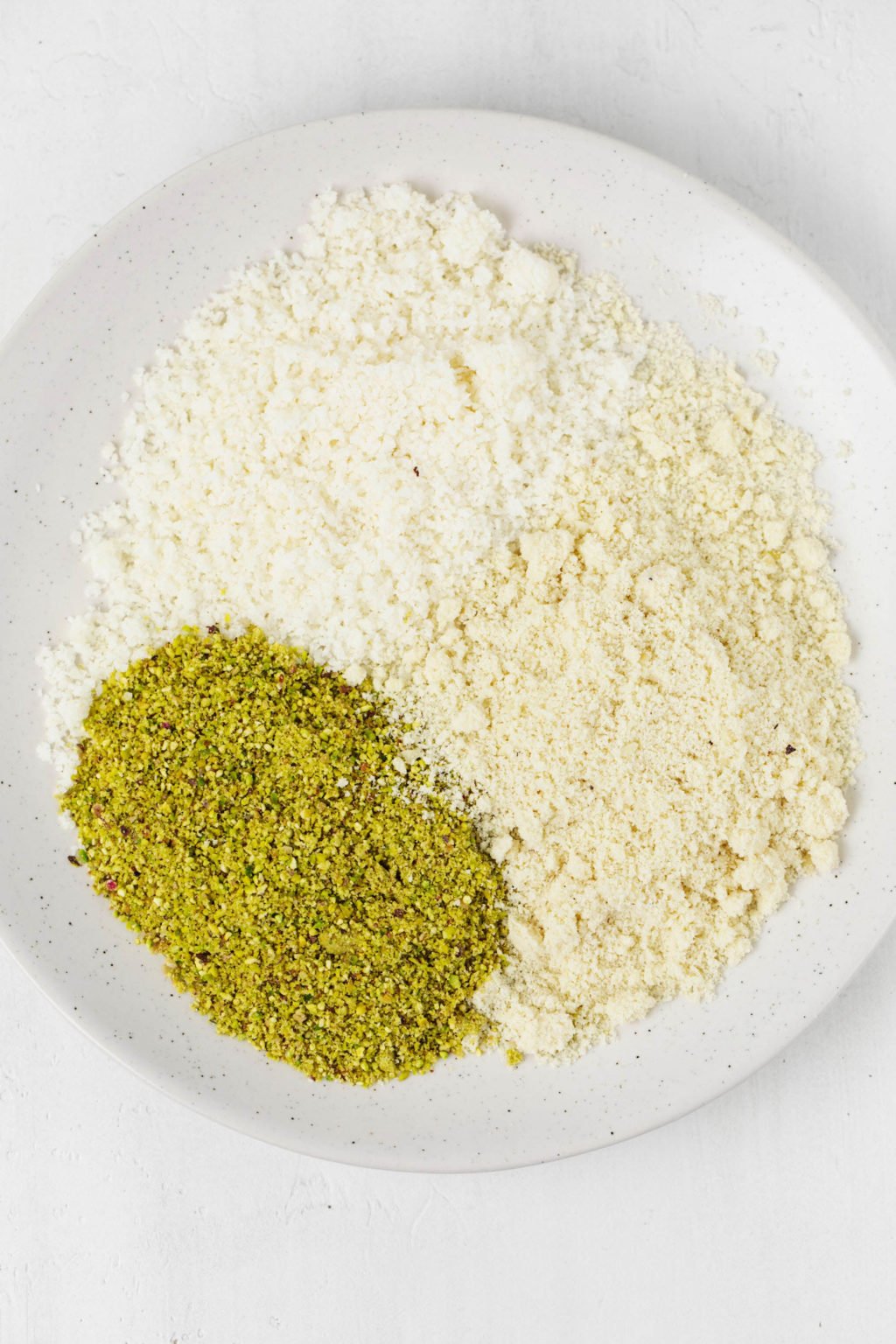
How to make vegan pistachio cake
While making this cake was an adventure for me, the actual process of making it was similar to many of my other go-to cakes.
Prepare your cake pan
The first step is to prepare an 8-inch, round springform cake pan. If you don’t have springform, a cake pan with a removable bottom will also work.
If you don’t have a round cake pan that’s either springform or has a removable bottom, then a round, non-stick cake pan is OK. However, it has to be nonstick, and you’ll want to grease or oil it very well.
I also recommend lining the bottom of the cake pan with a round of parchment.
Mix dry ingredients
Next, you’ll combine the dry ingredients together in a large mixing bowl. If you’re making the pistachio flour from scratch, you’ll do that before mixing the flours together.
Mix wet ingredients
After this, you’ll combine the wet ingredients together in a separate bowl. Then, you’ll add them to the dry ingredients. Mix the ingredients well to combine. Since this is a gluten-free cake recipe, there’s no danger of over-mixing.
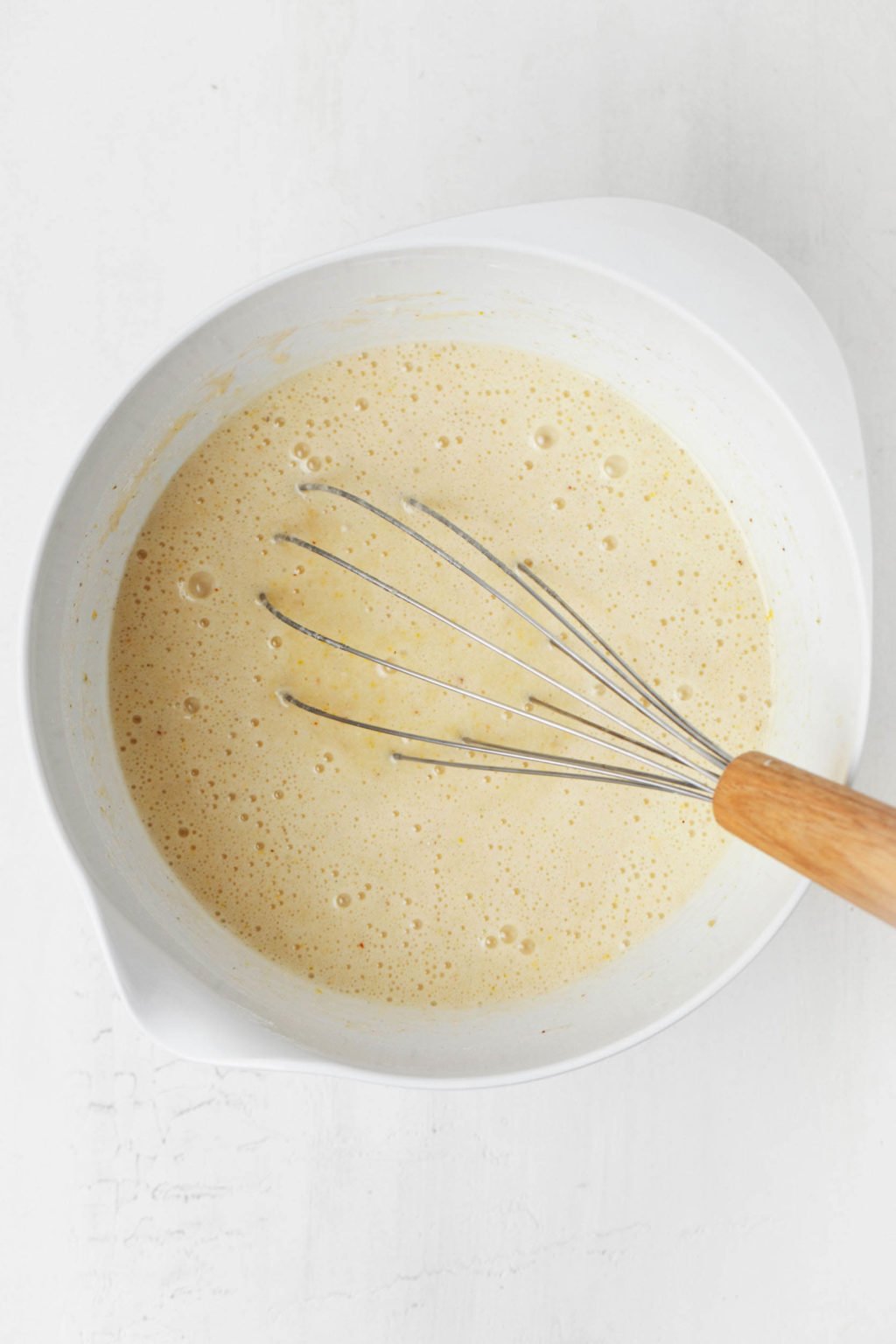
Transfer & bake
Next, you’ll transfer the batter to your prepared cake pan. You may need to use a spatula to help with the transfer. You’ll also use this spatula (or an offset spatula) to gently smooth the top of the cake over.
The cake needs about 45-50 minutes to bake. When the cake finishes baking, you may notice that it’s not as puffy or “set” in the center as regular (grain-based) vegan cakes.
This is normal! The pistachio cake will retain a dense texture in the center even after it is fully baked. It shouldn’t be liquid or raw by any means. But it may be moist. The cake will continue to firm as you store it.
Cool
After baking, the cake needs a few hours to cool, at least, before you can frost it.
I recommend cooling the pistachio cake for a full 4 hours prior to making the glaze and frosting the cake. If you prefer, you can let the cake come to room temperature, then wrap it lightly with plastic wrap and continue cooling it in the fridge overnight.
Glaze
The glaze for this cake is simple: lemon juice and confectioners sugar. Note that, if you are preparing the cake for Passover, you’ll need to use Kosher for Passover certified confectioners sugar.
It’s also possible to make confectioners (powdered) sugar at home with Kosher sugar if you have a high-speed blender. Here’s a tutorial on the process.
Once the glaze is ready, you’ll pour it over the cake. You can sprinkle the cake with chopped, shelled pistachios if desired.
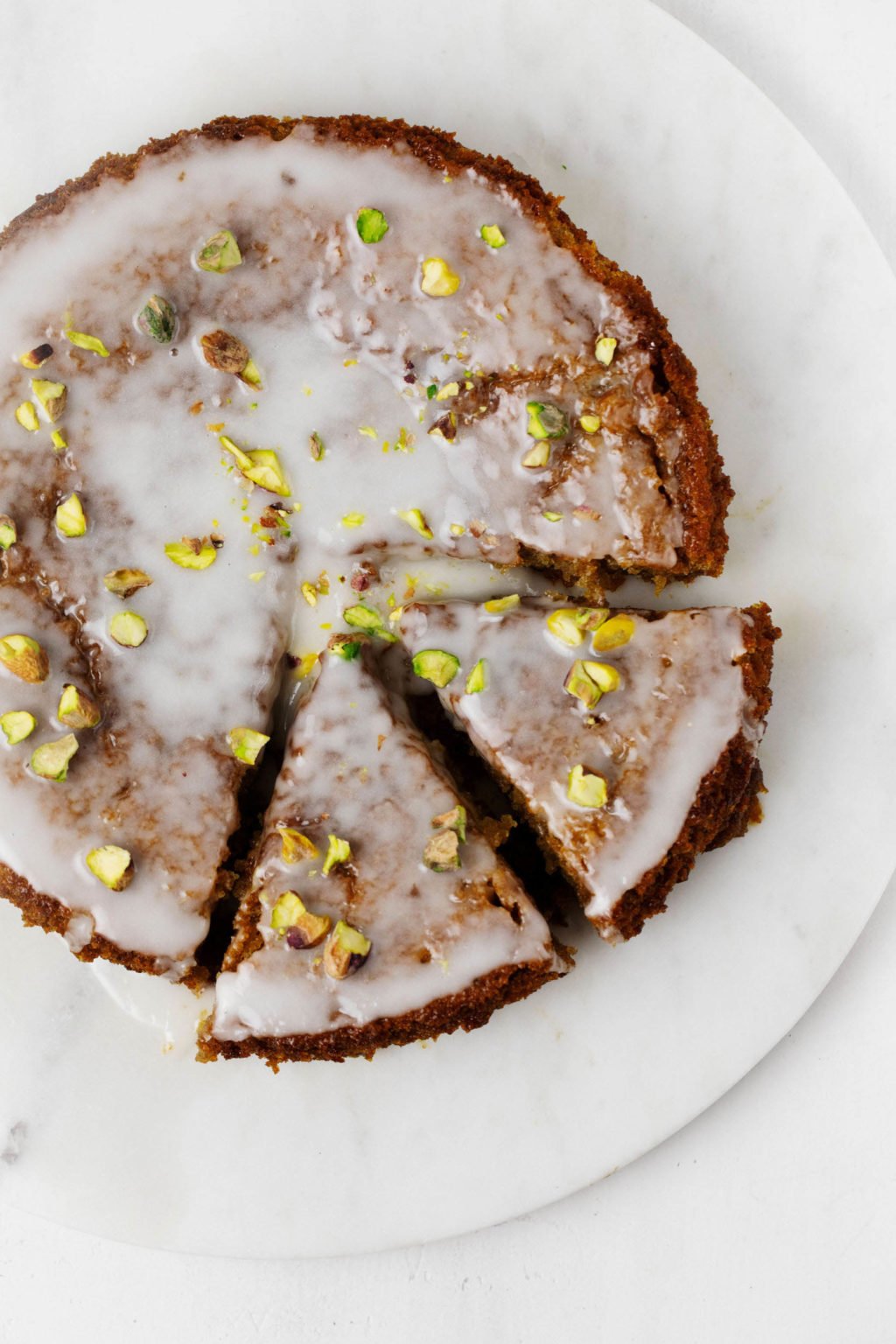
Cool & set
Now the cake needs one more interval of cooling time. This will help the glaze on the cake to set!
Transfer the glazed and decorated cake to the fridge for 2-3 hours, uncovered. At this point, you can slice and serve. You can also cover the cake gently with plastic wrap, then store the cake overnight in the fridge.
This pistachio cake benefits from more time to set, rather than less. So it’s a good cake to prepare one day in advance of serving and sharing.
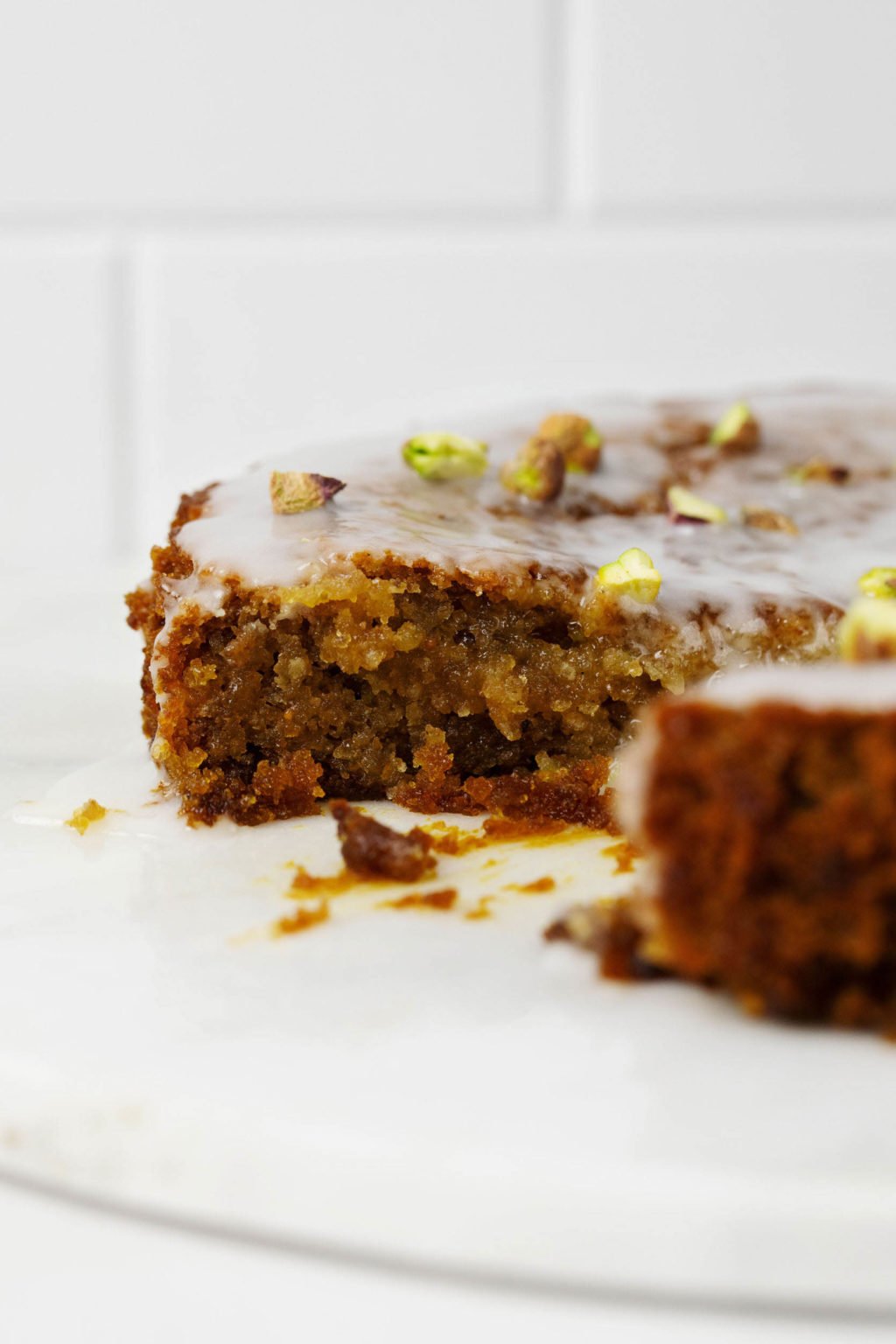
Storage
I recommend storing the lemon pistachio cake in the fridge, wrapped lightly with plastic wrap.
Stored in this way, the cake will keep for up to four days in the fridge.
Can I freeze the lemon pistachio cake?
Yes, you can freeze the lemon pistachio cake! It’s possible to freeze either the entire cake, or to freeze individual slices, depending on what you have left over.
The cake can be frozen for up to 6 weeks. Defrost the cake (or individual slices of cake) in the fridge overnight. Allow the slices to come to room temperature before enjoying.
One thing to note is that this is already a relatively moist cake. So, if you do freeze and defrost, the texture may be a little stodgy. The cake will still be delicious; however, if you’re making it for company, you may want to prepare it fresh.
More creative vegan cake recipes
If you enjoy this unusual, delicious cake, then you may enjoy these other vegan delights for snacking, sharing, and savoring!
- Vegan chocolate beet cake
- Pumpkin carrot cake with cream cheese frosting
- Peanut butter and jelly snack cake
- Golden milk cake with coconut frosting
- Sweet cherry upside down cake
- Banana cake with creamy cashew frosting
- Dark chocolate pear cake
- Vegan Nantucket cranberry pie (it’s actually a cake!)
Plus, 20 irresistable vegan cake recipes.
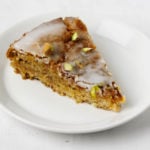
Vegan Lemon Pistachio Cake
Author –Ingredients
- 3/4 cup coconut flour
- 3/4 cup blanched almond flour
- 2/3 cup pistachio flour or very finely ground pistachio nuts
- 1/3 cup arrowroot or potato starch
- 1 teaspoon baking powder
- 1/2 teaspoon baking soda
- 1/4 teaspoon fine salt
- 2/3 cup cane sugar
- 1/4 cup avocado oil (or another neutral vegetable oil)
- 1/4 cup freshly squeezed lemon juice
- 1/4 cup maple syrup
- 3/4 cup cold water
- 1 teaspoon vanilla extract
- 1 cup confectioners’ sugar
- 2 tablespoons lemon juice
- chopped pistachio nuts, if desired
Instructions
- Preheat your oven to 350F and line an 8″ square or springform round pan with parchment.
- In a large mixing bowl, whisk together the flours, pistachio nuts, arrowroot, baking powder and soda, salt, and sugar.
- In a separate, medium mixing bowl, whisk together the oil, lemon juice, syrup, water, and vanilla.
- Add the wet ingredients to dry, and whisk together till the batter is smooth. If your batter is very thick upon mixing, add a little additional water by the tablespoon until it is thick, but can be poured into the baking pan with the help of a spatula and some encouragement from you.
- Immediately transfer the batter into the prepared cake pan. Use a spatula to smooth over the top. Bake for 45-50 minutes, or until the cake is golden brown.
- When the cake is ready, allow it to cool for 4 hours on a wire rack. At this point, you can let the cake come to room temperature, then wrap it gently with plastic wrap and allow it to cool overnight if that suits your schedule.
- When you are ready to glaze the cooled cake, whisk together the lemon juice and confectioners' sugar. Pour this glaze over the cake and spread it gently with a spatula, if needed. Top with chopped whole pistachio nuts.
- Transfer the cake to the fridge and allow it to set for another 2-3 hours (or overnight). Cut and serve.
Notes
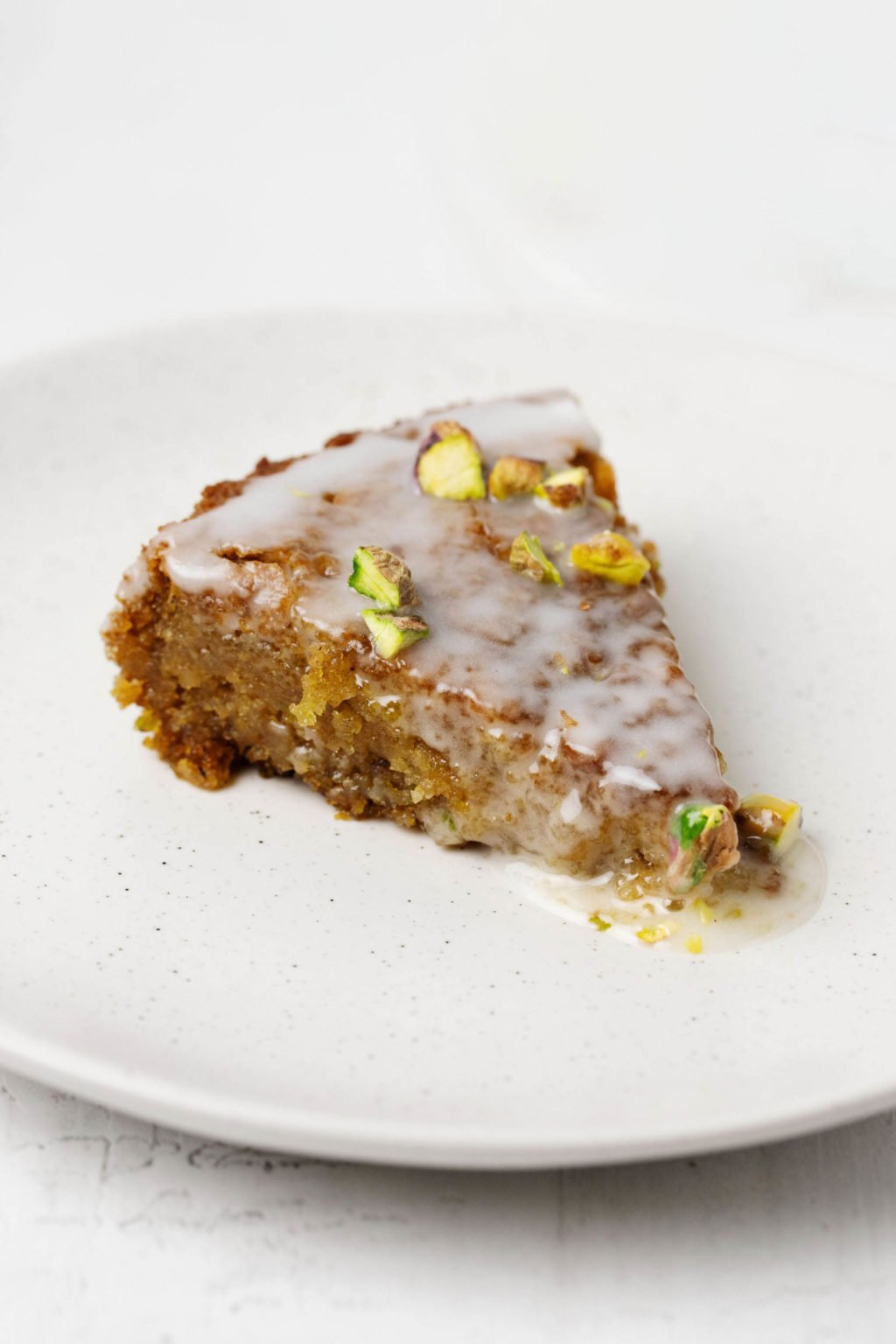
While I first created this cake with Passover in mind, it’s a lovely Easter offering, too.
And there’s no reason to wait until a holiday to prepare it! The cake is lovely for spring, with its lemony notes, and it’s a burst of bright, citrusy sweetness in the wintertime.
In other words, it’s a treat to savor no matter the season. I hope that you enjoy it!
xo
This post may contain affiliate links. If you use these links to buy something I may earn a commission. Visit my privacy policy to learn more.

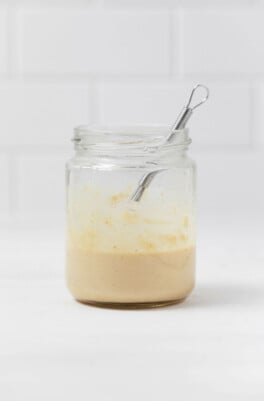
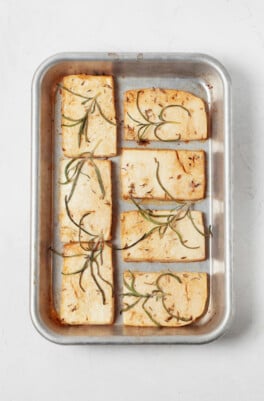
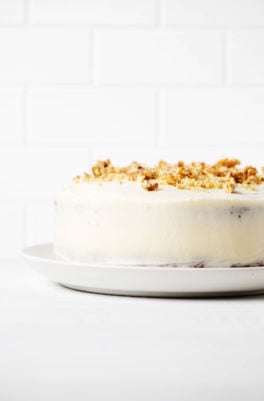
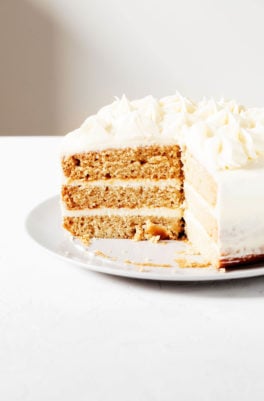
Leave a Comment
Could I replace the coconut flour with pistachio flour or almond meal due to coconut allergy.or any other option for the coconut flour replacement. Thanks
You could use blanched almond flour or pistachio flour, yes!
I wish you had the nutritional information accompanying these recipes thanks so much for listening
Love this recipe, it is easy and so tasty!!! I just finished it last night and the result was unexpected, my wife and daughter both liked it, which made me happy. Thanks for your recipe
So glad your family likes it, Elliott!
are there any feasible confectioners sugar replacements for a paleo diet?
Unfortunately, for an icing like this, I don’t know of a good replacement, Tammi. But I’ll loop back if I learn of one!
This is awesome recipe. Thank you!
Passover isn’t just about avoiding grains, more importantly one must not use leavening agents. This recipe contains two such agents and thus would not be considered acceptable for Passover.
I did not realize that—thank you for informing me!
This is simply not true. I have both baking soda and baking powder with big kosher for passover signs on them. Kosher for passover is about not eating grains that have been exposed to moisture for more than 18 minutes. I will be making this for my passover meal tomorrow.
I just read through the comments and saw that someone else had to really spread and pat down their batter into their pan also. Would this make it less likely to rise also? If so, should I just add more water to make it thinner? Also, when I processed my pistachios, they were quite wet and crumbly, not like flour. Did you use purchased flour or grind your own? If you did grind, were they at like mine? I want to make this cake again but I’d like it to rise more like yours. 🙂 Thanks!
Hi!
Yes, I’d add a little extra water if the batter is that thick.
I tested once with ground pistachio and once with pistachio flour. Flour gave me the pretty rise you see in the photo. My ground cake was more dense, but still some rise. My pistachios weren’t wet and crumbly. I ground them in a few small batches (that might be a key step) in food processor and got them dry and fine, though not quite like commercial flour. I hope this helps!
G
Thank you so much for the tips! 🙂
You’re so welcome! I hope it goes well on take 2! 🙂
Wow! This was delicious. I accidentally left the batter sitting for too long before going in the oven so mine didn’t rise like yours, but it was still so good! I took it to a dinner with meat and dairy eaters and everyone loved it!
HI, Thanks for sharing such kind of interesting post here. Love to read you. Thanks for sharing keep it up
Hi Gena,
I was looking for a new recipe for breakfast. I find this article. I like your coconut lemon cake recipe. Thanks for sharing.
Your coconut lemon cake is perfect. I like your recipe. Its look yummy. Thanks for sharing.
Question! I just made this but when I combined the wet & dry, it was not a pourable batter AT ALL. I had to sort of pack it in the springform pan; it was a little softer than cookie dough. Is that OK ? I just put in oven so I wait.. I was loving it up until then, I am now just concerned bc I have a lot of Passover cooking to do! 🙂
Hey Sara! I think I answered your question via Instagram but have my fingers crossed for you! Sometimes different coconut flours can be more or less thirsty, which could be a part of why your batter was more stiff than mine was.
This is wonderful! Note that anyone keeping Passover will likely need to make their own confectioners sugar using potato starch as Kosher for Passover can be hard to find…otherwise this rocks!! Thanks a ton!
I’m glad you mentioned this, Adrienne! Thank you so much—I didn’t know.
I just wanted to add that if you make confectioner’s sugar fresh, you shouldn’t need anything other than sugar. Just grind sugar in a coffee grinder or spice mill under it becomes a fine powder and use immediately.
Gena, what a lovely combination of flavors! I also went and looked at the other recipes and loved how you came up with an “amalgam”–my kind of experiment! (Plus, I really love the word “amalgam.”) The lemon sugar glaze is nostalgic of my grandmother’s lemon jello cake that we often had at Easter. In later years and in an ecumenical spirit we also did a Passover dinner, but I don’t remember that anyone came up with a cake for it. All this inventive baking was yet to come on the scene. This is a little too high fat for me, but I think it’s such a splendid holiday creation that I will share it on my blog’s facebook page in case someone is looking for a Seder or Easter special treat. Thank you! xo